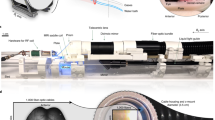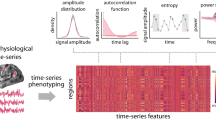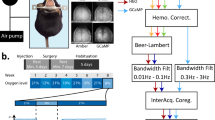Abstract
Functional magnetic resonance imaging is an important tool for measuring brain function noninvasively, but the vascular and metabolic changes on which its measurements are based are not fully understood. Here, we examined the relationship between these changes and neural activity on a fine spatial scale through simultaneous measurements of tissue oxygen and extracellular neural activity in the cat lateral geniculate nucleus. Our findings indicate that activity-dependent increases in cerebral blood flow and oxidative metabolism occur on different spatial scales, and that the ratio between the two depends on the size of the activated neural population.
This is a preview of subscription content, access via your institution
Access options
Subscribe to this journal
Receive 12 print issues and online access
$209.00 per year
only $17.42 per issue
Buy this article
- Purchase on Springer Link
- Instant access to full article PDF
Prices may be subject to local taxes which are calculated during checkout


Similar content being viewed by others
References
Fox, P.T. & Raichle, M.E. Proc. Natl. Acad. Sci. USA 83, 1140–1144 (1986).
Hoge, R.D. et al. Proc. Natl. Acad. Sci. USA 96, 9403–9408 (1999).
Mandeville, J.B. et al. Magn. Reson. Med. 42, 944–951 (1999).
Kim, D.S., Duong, T.Q. & Kim, S.G. Nat. Neurosci. 3, 164–169 (2000).
Malonek, D. & Grinvald, A. Science 272, 551–554 (1996).
Yacoub, E. et al. NMR Biomed. 14, 408–412 (2001).
Menon, R.S. et al. Magn. Reson. Med. 33, 453–459 (1995).
Thompson, J.K., Peterson, M.R. & Freeman, R.D. Science 299, 1070–1072 (2003).
Sheth, S.A. et al. J. Neurosci. 24, 634–641 (2004).
Duong, T.Q., Kim, D.S., Ugurbil, K. & Kim, S.G. Proc. Natl. Acad. Sci. USA 98, 10904–10909 (2001).
Zheng, Y. et al. Neuroimage 16, 617–637 (2002).
Sanderson, K.J. J. Comp. Neurol. 143, 101–108 (1971).
Lindauer, U. et al. Internat. Congr. Ser. 1235, 137–144 (2002).
Buxton, R.B. Neuroimage 13, 953–958 (2001).
Acknowledgements
We thank B. Li, S. Bierer and L. Altamirano for help with data collection. This work was supported by National Eye Institute grants EY01175 and EY03176.
Author information
Authors and Affiliations
Corresponding author
Ethics declarations
Competing interests
The authors declare no competing financial interests.
Supplementary information
Supplementary Fig. 1
Maximum stimulus-induced signal change and SNR for positive and negative oxygen responses at each of the 34 recording sites. (a) Response amplitude. Each point (●) represents the maximum stimulus-induced change in oxygen (positive and negative) observed at a given recording site during the first 8 seconds following stimulus onset. Mean values (arrows) are 15.8 ± 10.8% and −5.6 ± 4.1% for positive and negative changes, respectively. (b) Response SNR. Values from (a) were divided by the noise in the baseline oxygen signal. Noise is determined by the standard deviation of the raw baseline oxygen signal (expressed in percent change). Mean values are 4.1 ± 1.8 and −1.3 ± 0.8 for positive and negative SNRs respectively. Open squares (□) represent values observed from the example recording site shown in Figure 1. (PDF 29 kb)
Rights and permissions
About this article
Cite this article
Thompson, J., Peterson, M. & Freeman, R. High-resolution neurometabolic coupling revealed by focal activation of visual neurons. Nat Neurosci 7, 919–920 (2004). https://doi.org/10.1038/nn1308
Received:
Accepted:
Published:
Issue Date:
DOI: https://doi.org/10.1038/nn1308
This article is cited by
-
Imaging local neuronal activity by monitoring PO2 transients in capillaries
Nature Medicine (2013)
-
Spatial Specificity of BOLD versus Cerebral Blood Volume fMRI for Mapping Cortical Organization
Journal of Cerebral Blood Flow & Metabolism (2007)
-
Heterogeneous Oxygen Extraction in the Visual Cortex during Activation in Mild Hypoxic Hypoxia Revealed by Quantitative Functional Magnetic Resonance Imaging
Journal of Cerebral Blood Flow & Metabolism (2006)
-
Cerebral Oxygenation during Postasphyxial Seizures in Near-Term Fetal Sheep
Journal of Cerebral Blood Flow & Metabolism (2005)



